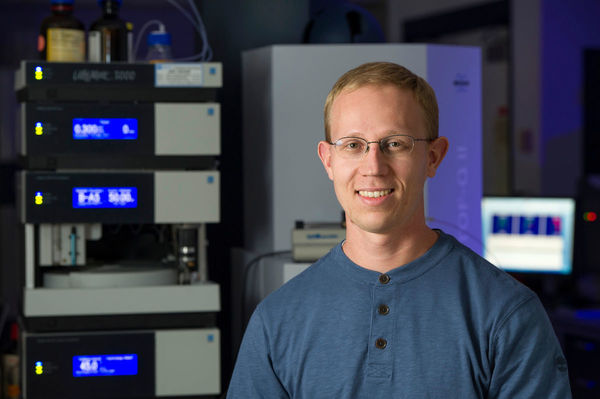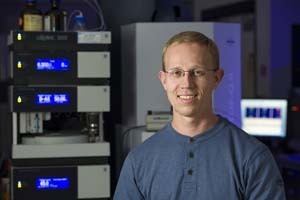

A collaboration between Jon Camden, an associate professor in the Department of Chemistry and Biochemistry, David Masiello of the University of Washington, and Philip Rack of the University of Tennessee has directly observed hybridized magnetic resonances in plasmonic nanostructures for the first time. The achievement is a critical step toward developing materials that interact with light in unexpected ways and that may someday cloak military equipment throughout the visible spectrum or underlie future PV technology optimized to capture energy from the sun’s infrared rays. Their paper on the work, “STEM/EELS Imaging of Magnetic Hybridization in Symmetric and Symmetry-Broken Plasmon Oligomer Dimers and All-Magnetic Fano Interference,” was published in the American Chemical Society’s Nano Letters.
Camden and Masiello started their investigation years ago to understand how plasmonic nanostructures transfer energy into their surroundings. Masiello’s group focuses on theory and simulations to make predictions that they send to Camden, who uses sophisticated spectroscopic equipment – involving electron microscopes and lasers – to test the predictions in the real world.
Nanomaterials such as plasmonic nanostructures can interact with light in exotic and counterintuitive ways in comparison with ordinary materials. To achieve a material that cloaks, for example, it must have a doubly negative index of refraction, meaning that its electric permittivity (response to electric fields) and magnetic permeability (response to magnetic fields) are both negative at the same frequency. Cloaking has been achieved in some parts of the spectrum, but not so far at visible wavelengths.
In this work, the researchers provide a thorough understanding of the magnetic properties of cyclic assemblies of metallic nanoparticles in the hopes that these basic building blocks can be assembled into larger functional materials in the future such as those with doubly negative indices of refraction. The observations demonstrate the power of combining advanced electron microscopy with theoretical simulations and nanofabrication techniques.
The collaborators plan to continue research to achieve the doubly negative effect across multiple colors of the visible spectrum. They also plan to investigate other unique properties of the materials, using their greatly enhanced magnetic fields to learn how energy is transferred between particles on the nanometer length scale and how to examine the ordinarily exceedingly weak magnetic scattering properties of molecules in the field. Another one of their proposals involves enhancing solar light harvesting in the infrared, which often becomes heat rather than useful energy in current technology.
The collaboration involves graduate students and postdoctoral associates working in physics, materials science, applied mathematics, and chemistry. Camden’s research is supported by Notre Dame and the Department of Energy. Masiello’s research is supported by the University of Washington and the National Science Foundation. The Nano Letters paper is available at http://pubs.acs.org/doi/abs/10.1021/acs.nanolett.6b03504.
Originally published by Gene Stowe at science.nd.edu on October 12, 2016.